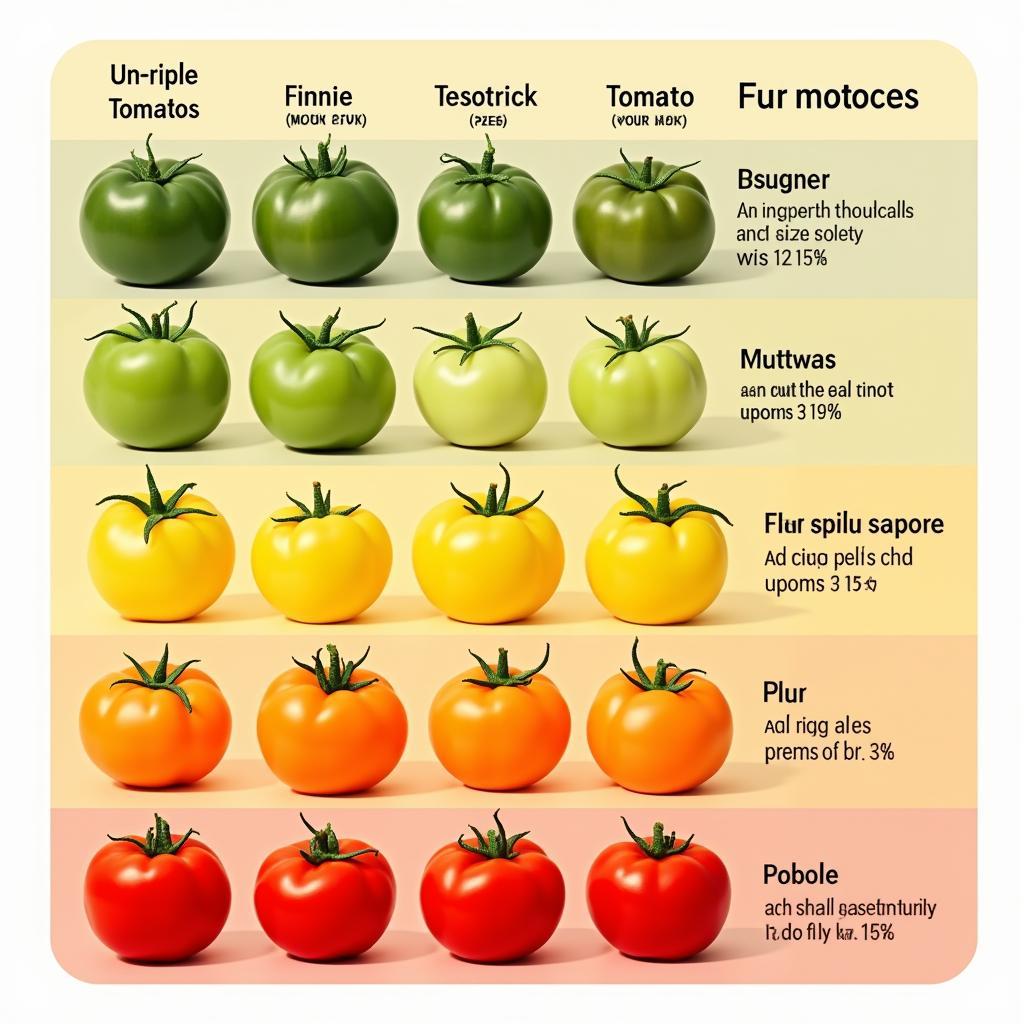The vibrant color of a tomato is a familiar sight in kitchens worldwide. But defining “what color is a tomato” isn’t as straightforward as it seems. Ripe tomatoes boast a spectrum of hues, from fiery orange-red to deep crimson, and even shades of yellow and green in certain varieties. This article delves into the fascinating world of tomato colors, exploring the science behind their hues, the variety of shades, and how color impacts flavor and ripeness.
While the classic image of a tomato is a bright red, the truth is far more nuanced. Factors such as variety, growing conditions, and ripeness all play a role in determining the final color of a tomato. Understanding these factors can help you select the perfect tomato for your culinary needs. Similar to choosing the right what color homecoming dress should i wear, selecting a tomato based on color can be a game-changer.
The Science Behind Tomato Color
The vibrant colors of tomatoes are due to pigments called carotenoids, specifically lycopene, which gives them their red hue. Other carotenoids like beta-carotene and lutein contribute to orange and yellow tones. Chlorophyll, the pigment responsible for the green color in plants, is also present in tomatoes, especially in unripe fruit. As the tomato ripens, chlorophyll breaks down, revealing the underlying carotenoid colors.
 Tomato Color Spectrum: Ripe and Unripe Tomatoes
Tomato Color Spectrum: Ripe and Unripe Tomatoes
What are the Different Colors of Tomatoes?
Tomatoes come in a stunning array of colors, offering a visual feast and a diverse range of flavors.
- Red: The most common color, ranging from bright scarlet to deep crimson. Lycopene is the dominant pigment in red tomatoes.
- Orange: These tomatoes have a higher concentration of beta-carotene, giving them their distinctive orange hue.
- Yellow: Yellow tomatoes contain lutein, a carotenoid that contributes to their bright yellow color.
- Green: While unripe tomatoes are green due to chlorophyll, some varieties, like Green Zebra, retain their green color even when ripe.
- Purple/Black: These unique tomatoes contain anthocyanins, the same pigments that give blueberries their color.
- Striped: Some varieties, like Tigerella, display striking stripes of red, yellow, and orange.
How Does Color Affect Flavor?
While color isn’t a direct indicator of flavor, it can provide some clues. Generally, red tomatoes are associated with a balanced sweetness and acidity. Orange and yellow tomatoes tend to be sweeter and less acidic, while green tomatoes can be tart. Purple and black tomatoes often have a rich, complex flavor profile.
How to Tell if a Tomato is Ripe
Color is a key indicator of ripeness, but it’s not the only factor. A ripe tomato should have a vibrant color specific to its variety. It should also feel firm but slightly yielding to the touch and have a pleasant aroma. Knowing what color is a tomato at its peak ripeness is essential for the best flavor.
What Color Grow Light is Best for Tomatoes?
If you’re growing tomatoes indoors, choosing the right grow light is crucial for optimal color development and fruit production. This is similar to understanding what color grow light is best for indoor plants in general. While specific recommendations may vary, a combination of red and blue light is often considered ideal for tomato growth. Red light promotes flowering and fruiting, while blue light encourages vegetative growth.
When to Plant Tomatoes in Colorado
Knowing the best time to plant tomatoes in Colorado depends on various factors, including the specific region and the last frost date. It’s crucial to research the appropriate planting time for your area to maximize your harvest. For detailed guidance, check out our article on when to plant tomatoes in colorado.
Conclusion
The color of a tomato is more than just a visual characteristic; it’s a window into its ripeness, flavor profile, and even the science behind its development. From the common red to the exotic purple, each color tells a story. By understanding the nuances of tomato color, you can choose the perfect tomato to enhance your culinary creations.
FAQ
- Are all red tomatoes the same flavor? No, even within the red color range, flavors can vary depending on the variety.
- Why are some tomatoes green when ripe? Certain varieties, like Green Zebra, are bred to retain their green color even when ripe.
- Are heirloom tomatoes always more colorful than hybrid varieties? Heirloom tomatoes often come in a wider array of colors than hybrids.
- Do different colored tomatoes have different nutritional values? Yes, different colored tomatoes offer varying levels of nutrients and antioxidants.
- How should I store tomatoes? Store ripe tomatoes at room temperature and avoid refrigeration, which can affect their flavor.
- Can I eat green tomatoes? Yes, green tomatoes can be used in various recipes, including fried green tomatoes.
- What is the best way to ripen tomatoes? Leave them at room temperature, stem-side down, out of direct sunlight.
Need more help with your tomato adventures? Contact us at 0373298888, email us at [email protected], or visit us at 86 Cầu Giấy, Hà Nội. We have a 24/7 customer support team ready to assist you.
